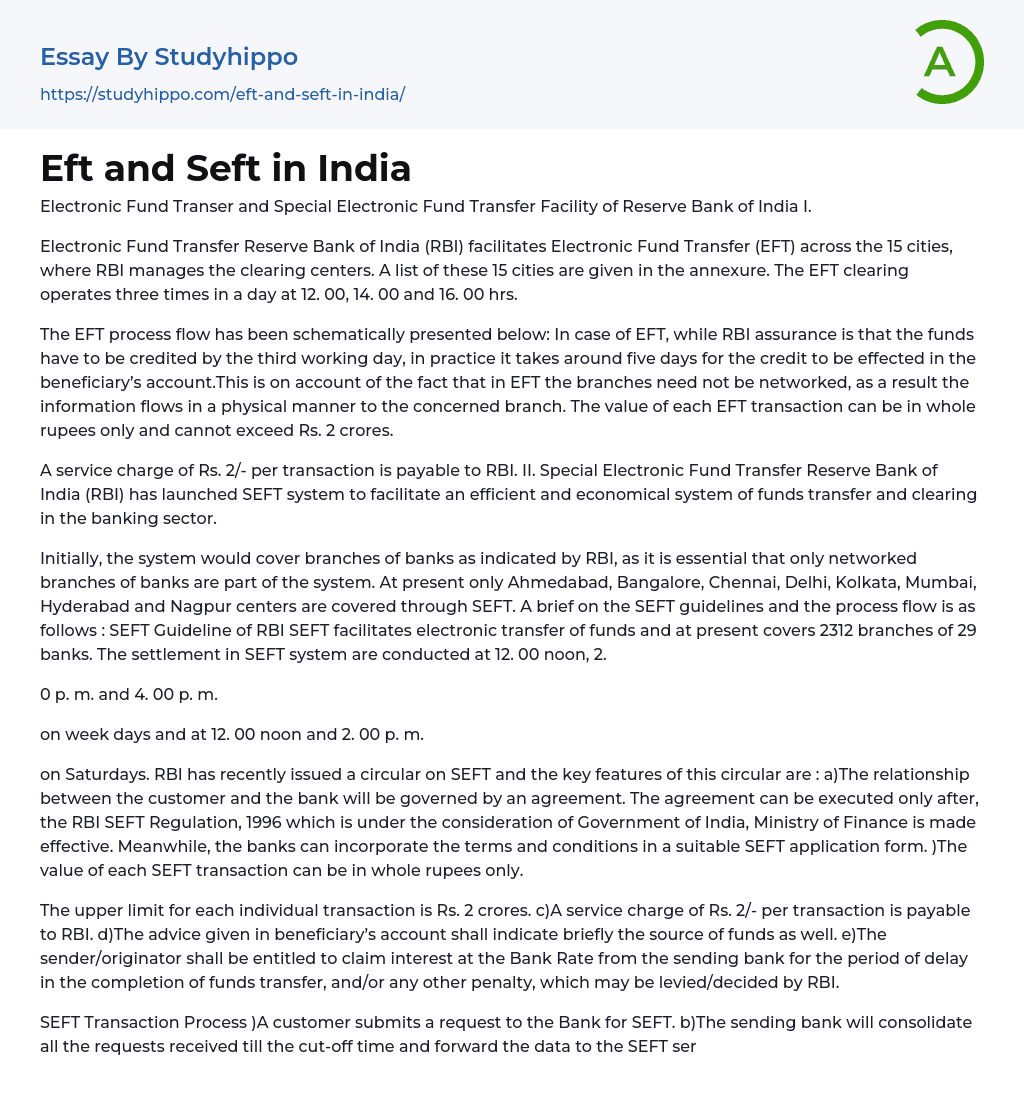The Reserve Bank of India provides two options for electronic fund transfer: Electronic Fund Transfer and a Special Electronic Fund Transfer Facility.
The RBI provides EFT services via managed clearing centers in 15 cities, which are listed in the annexure. There are three daily EFT clearings at 12:00pm, 2:00pm, and 4:00pm.
The diagram illustrates the EFT process flow, which typically takes around five days for funds to be credited to the beneficiary's account due to physical information flow between branches. Although guaranteed by the Reserve Bank of India, funds may take longer than the promised three working days. EFT transactions do not require networked branches and should not exceed Rs. 2 crores while being conducted in whole rupees.
The SEFT system has been implemented by the Reserve Bank of India (RBI) to improve the efficiency and cost-effectiveness of fund transfe
...rs and clearing in the banking sector. For every transaction, RBI will charge a fee of Rs.2/- which must be paid directly to them.
The SEFT system is currently operational in specific bank branches determined by RBI. These branches are located in Ahmedabad, Bangalore, Chennai, Delhi, Kolkata, Mumbai, Hyderabad and Nagpur centers. The electronic transfer of funds is facilitated among 2312 branches across 29 banks through the networked SEFT system. Settlements occur twice a day at 12:00 noon and 2:30 PM. RBI provides guidelines for using the SEFT system along with its process flow.
From noon to 4:00 in the afternoon.
Events take place on weekdays at two designated times: 12:00 noon and 2:00 p.m.
RBI released a circular on Saturdays pertaining to SEFT that highlights two main points. Firstly, an agreement between the customer and the bank is required for which executio
can only take place upon the effectiveness of the RBI SEFT Regulation, 1996. Until then, banks are permitted to include terms and conditions in a suitable SEFT application form. Secondly, each SEFT transaction must be valued in whole rupees.
Transactions cannot exceed Rs. 2 crores and a service charge of Rs. 2/- per transaction is mandated by the RBI. The recipient's account must be notified of the funds' origin. Interest at the Bank Rate, as well as any penalties imposed by the RBI, may be claimed by the initiator in case of delay.
The process of SEFT transaction involves the following steps: a) A customer initiates a request for SEFT with the Bank. b) The sending bank collects all the requests until the cut-off time and sends the data to its SEFT service branch. A bank can have only one service branch. c) The SEFT service branch uses the package provided by RBI's National Clearing Cell (NCC) to prepare the data file.
NCC serves as the SEFT Centre for data processing. The SEFT service branch must use RBI's designated communication network to send the data file to the SEFT Centre. The SEFT Centre then consolidates all data files received from participating banks and generates settlement for each beneficiary bank. Processed data files are accessible on RBI's secure website and must be downloaded by each bank immediately after the conclusion of each settlement zone.
The SEFT service branch will receive and verify processed data files using the validation routine included in the SEFT package. The package checks for encryption key exchange and checksum total at a file level, as well as validation of individual records. Once validated, the
branch should transmit the data to the relevant beneficiary branches without expecting acknowledgements under the SEFT scheme.
It is important that any message that has not been returned by the next settlement zone is considered completed and credited to the beneficiary's account by their branch. To ensure this, any unaffected credits must be re-sent as new SEFT transactions during the immediate next settlement.
- Commercial Bank essays
- Debit Card essays
- Deposit Account essays
- Subprime Lending essays
- Bank essays
- Banking essays
- Corporate Finance essays
- Credit Card essays
- Currency essays
- Debt essays
- Donation essays
- Enron Scandal essays
- Equity essays
- Financial Accounting essays
- Financial Crisis essays
- Financial News essays
- Financial Ratios essays
- Financial Services essays
- Forecasting essays
- Foreign Exchange Market essays
- Free Market essays
- Gold essays
- Investment essays
- Legacy essays
- Loan essays
- Market Segmentation essays
- Money essays
- Personal finance essays
- Purchasing essays
- Retirement essays
- Shareholder essays
- Stock Market essays
- Supply And Demand essays
- Venture Capital essays
- Bangladesh essays
- China essays
- Hong Kong essays
- India essays
- Japan essays
- Kuala Lumpur essays
- Malaysia essays
- Manila essays
- Pakistan essays
- Philippines essays
- Singapore essays
- Vietnam essays
- Vietnamese essays




